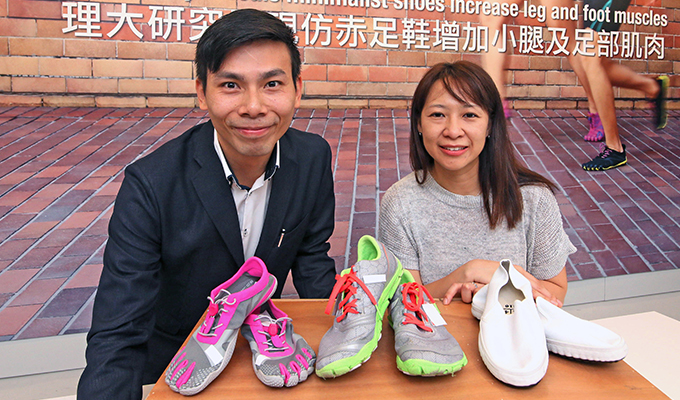A new wave of minimalist running emerged in recent years. It is believed that running in barefoot simulating shoes, compared to shod running, can better strengthen calf and foot muscles. In this issue, Dr Roy Cheung (left) at the Department of Rehabilitation Sciences introduced his recent study on minimalist shoes.
Can running shoes help prevent injury?
A study revealed that up to 79% of runners who ran more than 20 km per week were injured at least once a year. Another large-scale study involving over 7,000 US soldiers showed that footwear prescription according to foot posture offered little help against injury risk. In the recent barefoot bloom, a study found that barefoot running could switch landing patterns and reduce impact loading. However, barefoot running may not always be practical since objects on tracks may hurt runners’ feet.
Please introduce your recent study on minimalist shoes.
Minimalist shoes do not provide any support to the foot structure. I wanted to explore whether shod runners could strengthen their foot muscles after switching to wear minimalist shoes in running. This question has initiated my collaboration with the Harvard Medical School.
My research team recruited 38 subject runners with a mean age of 35 from local running clubs. They have been shod runners for approximately six years. Among them, 20 runners were randomly assigned to the experimental group. They were required to wear minimalist running shoes to undergo a six-month training programme covering muscle strengthening exercise and balance training. The other 18 runners in the control group took part in the same training programme, wearing their own traditional running shoes.
All subjects took the magnetic resonance imaging scanning to measure their right legs and foot muscle volume before and after the six-month training.
What are the differences between minimalist running shoes and traditional ones?
In terms of design, minimalist running shoes are lightweight footwear featuring an upper part made of stretchy fabric, zero heel-to-toe drop, no midsole cushioning or arch support, and a thin rubber outer sole for basic protection.
As minimalist running shoes provide minimal cushioning and no mechanical support to the foot arches, the intrinsic and extrinsic foot muscles, which function as important foot arch stabilisers, would experience greater demand for strength. When running with minimalist running shoes, the volumetric growth of extrinsic foot increases due to greater force generated in posterior and medical calf muscles, mid/forefoot landing imposes more stimuli to the anterior part of the foot, especially the metatarsophalangeal joint linking foot and toes, related muscles may therefore be strengthened.
What were the findings of the study?
The results showed that the subjects of the experimental group exhibited significantly more growth in leg and foot muscles: the extrinsic foot muscles (those attached from calf leg to foot) increased by 7.05% and the intrinsic foot muscles (those attached from heel to toes) increased by 8.8%. In contrast, the volume of leg and foot muscles of subjects in the control group remained unchanged.
We also found that the more the subjects wore their minimalist running shoes in running, the larger their growth of leg muscle volume.
This study indicated its potential application in rehabilitation programmes. We recommend that current clinical guidelines in treating conditions related to weak foot muscles be focused more on foot core muscle training, apart from relying on orthotic devices.
